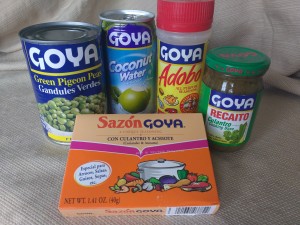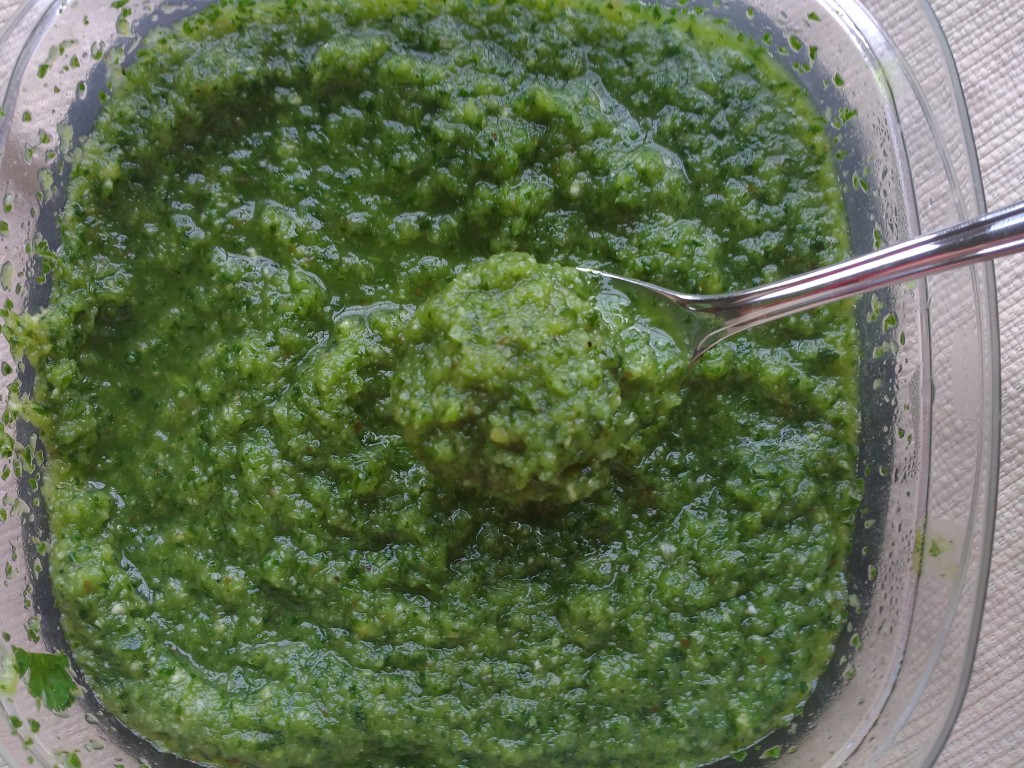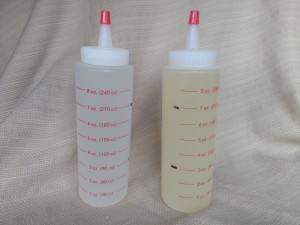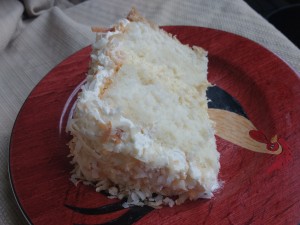I love experiencing the foods of other cultures! Recently, I was thrilled to do just that, when visiting dear friends and fellow competitors from Next Great Baker, David and Elaine Duran. David’s parents are from the Dominican Republic, while Elaine’s are from Puerto Rico. Elaine is known in the Orlando, Florida area as a successful cake artist and owner of Enticing Cake Boutique. Not only does she create amazing cakes, but she’s also well versed in her Puerto Rican culinary roots. And I’m going to share with you some of the delicious dishes she shared with me!
In my short time there, I realized a few things about ‘Spanish’ culture. (That term comes from New York City, where Spanish Harlem was the name of the area where many Puerto Ricans relocated.) First and foremost is the importance of family. When I say ‘family,’ I don’t just mean Mom, Dad and 1.8 kids. No, I mean, grandma and grandpa, sisters and brothers, aunts, uncles, and more cousins than you can count. They eat together, celebrate life events together, live near each other, and help each other. Second, they are full of life! They love to laugh, have animated conversations, and enjoy vibrant music and colorful surroundings. And third, their cuisine is close to their heart. However Mama made it, that’s how you want it, and that’s how you make it. Their food doesn’t consist of pricey ingredients and tricky techniques. Rather, they take common, inexpensive items and treat them with love. Life on the islands wasn’t (and isn’t) always easy. Over time, they developed a way of eating that made the most of what they had. And even though life might be much easier for today’s generation, the foods of the past create a common culinary identity that still binds them together. No matter what culture you’re from, there’s no taste like home!
So I hope you enjoy this ‘sabor de Puerto Rico’ as recreated by a mountain gal from Southern Appalachia. My attempt at Caribbean cooking might not be quite as good as Abuela (Grandma) Duran’s, but I think she’d give my version a thumbs up!
A note on ingredients: Look in the Hispanic aisle for Goya Sazon, Abodo, coconut water, green pigeon peas, and Recaito. If you live in my neck of the woods and know where to find fresh culantro (NOT cilantro!), let me know! A jar of Recaito, which has culantro in it, is the closest thing I’ve found so far.
Sofrito
This flavor-packed cooking base is simple to make, simple to keep, and flavors many dishes. And because you only need a heaping spoonful at a time, it goes a long way. Store in the refrigerator for a few days, or freeze for longer storage. This version is like the one Elaine made, except I added some non-spicy peppers. You can add a few plum tomatoes to yours if you wish.
2 cups of roughly chopped onion
2 cups of non-spicy peppers, like cubanelle or bell
2 heads of garlic (not 2 cloves, 2 heads!)
1 large bunch of fresh cilantro, roughly chopped
½ jar of Goya Recaito or 4 leaves of culantro, if you can find it
Salt and black pepper to taste
Place the onion and pepper in a food processor and purée. Add the other ingredients and continue to purée until smooth. Season to taste. You’ll use sofrito in the following savory dishes.
Pollo Guisado (Chicken Stew)
About 2 pounds of chicken thighs
¼ cup olive oil
About 2 cups of chicken stock
½ cup (4 oz) tomato sauce
1 packet Sazon
One large potato, peeled and chopped into 1 inch chunks
A few pieces of fresh cilantro
1 heaping tablespoon of sofrito
1 tablespoon vinegar
2 teaspoons oregano
Adobo seasoning to taste
Put olive oil into a large pot and turn to medium heat. Remove the skin from your chicken thighs, season the thighs with salt and pepper, and brown in oil, turning once. Put in enough broth and /or water to just cover the chicken thighs. Add all the remaining ingredients and check for taste, adding adobo seasoning as desired. Let simmer for an hour at least, or until the chicken falls off the bone. Bones can be removed for serving. As it cools, the delicious sauce will be partially absorbed by the potato. For my family, I double this recipePerfect when served over plain white rice or the following recipe, Arroz Con Gandules.
Arroz Con Gandules (Rice with Green Pigeon Peas)
One small onion, chopped
1 cup (or so) of chopped ham, or several slices cooked bacon
1/3 cup olive oil (or more to taste)
4 cups of rice
1 cup (8 oz) tomato sauce
1 15 oz can green pigeon peas, undrained
About 4 cups of chicken broth and/or water
1 tablespoon sofrito
A few pieces of fresh cilantro
1 packet Sazon
Adobo seasoning and pepper to taste
In a large pot, sauté onion and ham in the olive oil, just until onions start to become tender. Drain the liquid from the peas into a glass measuring cup. Add the tomato sauce and enough chicken broth/water to make 5 cups. Add this, plus the other ingredients, into the pot. Stir well and put on medium heat. As the mixture begins to simmer, stir well again, making sure rice isn’t sticking to bottom. Cover pot and leave on a low simmer for 20 to 25 minutes, until rice is cooked. Remove from heat, leave covered for 5 minutes, then uncover to fluff rice. Serve alone, or covered with Pollo Guisado. You can cut the recipe in half if you want a smaller amount.
‘Spanish’ Wet Cake
A Puerto Rican delicacy! Take your favorite vanilla cake recipe and bake into 8 inch rounds. For each round, you will ‘wet’ the cake with half a bottle (about 4 ½ ounces) of the following syrup:
3 ounces (5 tablespoons) sugar
6 ounces of water
Use a squirt bottle for easy measuring. Sugar goes to 3 oz mark, the rest is filled with water. Shake to dissolve. Store in the refrigerator until ready to use. One bottle makes enough for 2 8 inch rounds.
To wet the cake, first make sure the baked cake is completely cool. Place one baked round on your serving platter. I ‘crown’ the cake by trimming the baked surface off, making it easier to absorb the liquid. Going in a circle and starting from the outside and working in, start squirting the syrup onto the cake. When you reach the center, move in a circle from the inside out, repeating this action until half the bottle has been used. Put a filling on top (such as sweetened whipped cream or other filling), then place the next cake round on top. Make sure the top surface is ‘crowned’ so soaking is easy. Repeat the same soaking action on the top cake. Frost as desired, though whipping cream is the easiest frosting for this kind of cake.
Instead of plain water, you can add a variety of juices and extracts/flavorings to your syrup. When using juices, be sure and strain out any pulp as it will clog up the tip of your squirt bottle. Here are two versions:
Coconut Syrup
3 ounces of sugar
Coconut water, up to the 7 oz. mark
Fill the rest with coconut extract or coconut rum
Piña Syrup
3 ounces of sugar
Pineapple juice up all the way, or to the 7 oz mark, with the rest being pineapple rum.
You can use the juice from crushed pineapple, then use the leftover pineapple as a filling ingredient for your cake. This was the inspiration for the next recipe:
Piña Colada Cake
Using 2 8-inch rounds of your favorite vanilla cake, soak one round, placed on your serving platter, with the Coconut Syrup. Using your favorite vanilla pudding recipe with sweetened whipped cream and crushed pineapple folded in to taste, top the bottom round with this mixture, no more than ½ inch high. (Otherwise, you have a ‘shaky’ cake that is hard to cut!). Top with the remaining cake round and soak with the Piña Syrup. Cover sides with sweetened whipped cream (Cool Whip if you don’t want to make your own), and place more of your filling on the top. Cover the outside with toasted coconut and keep cake in the refrigerator until ready to serve.






